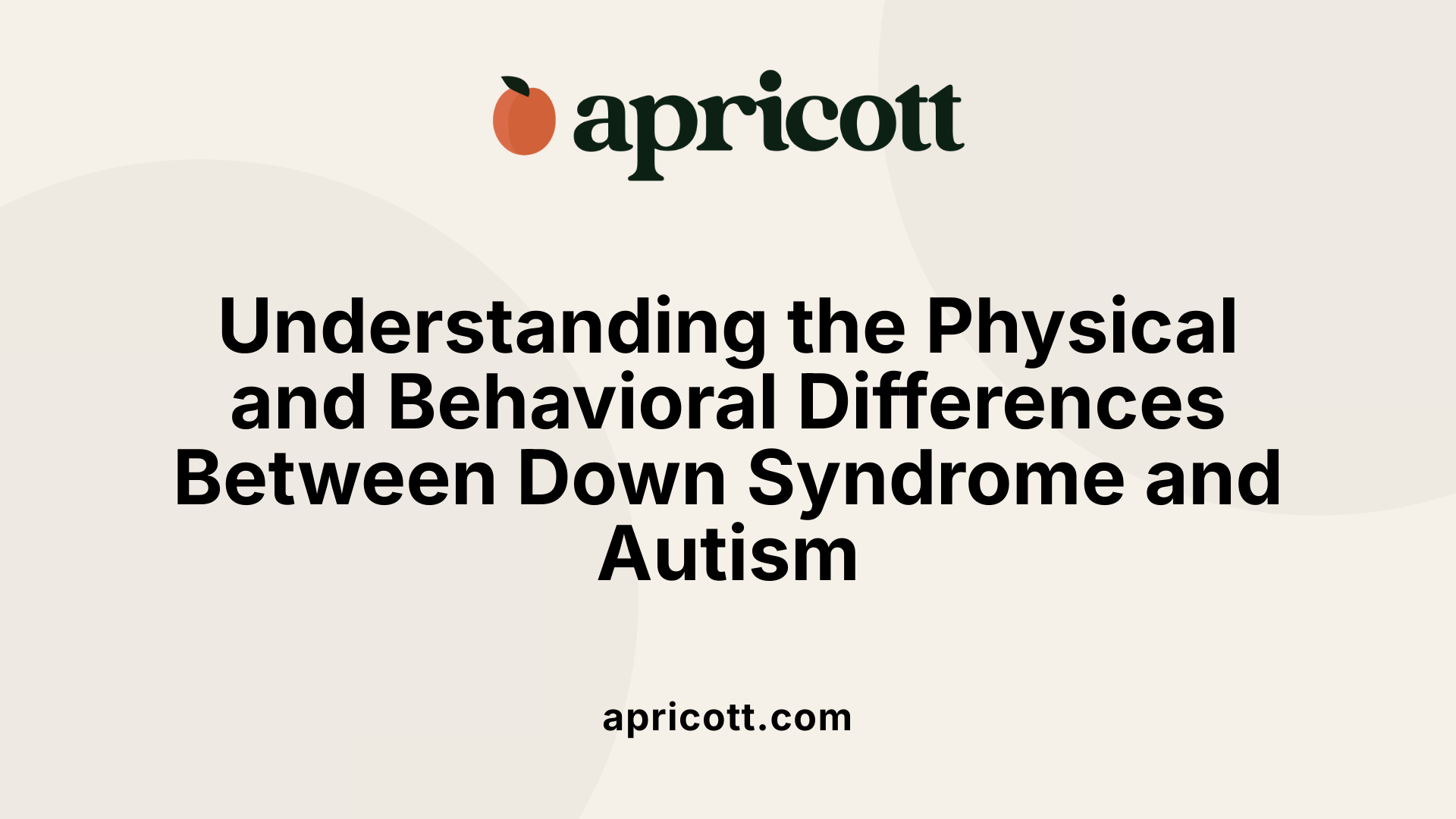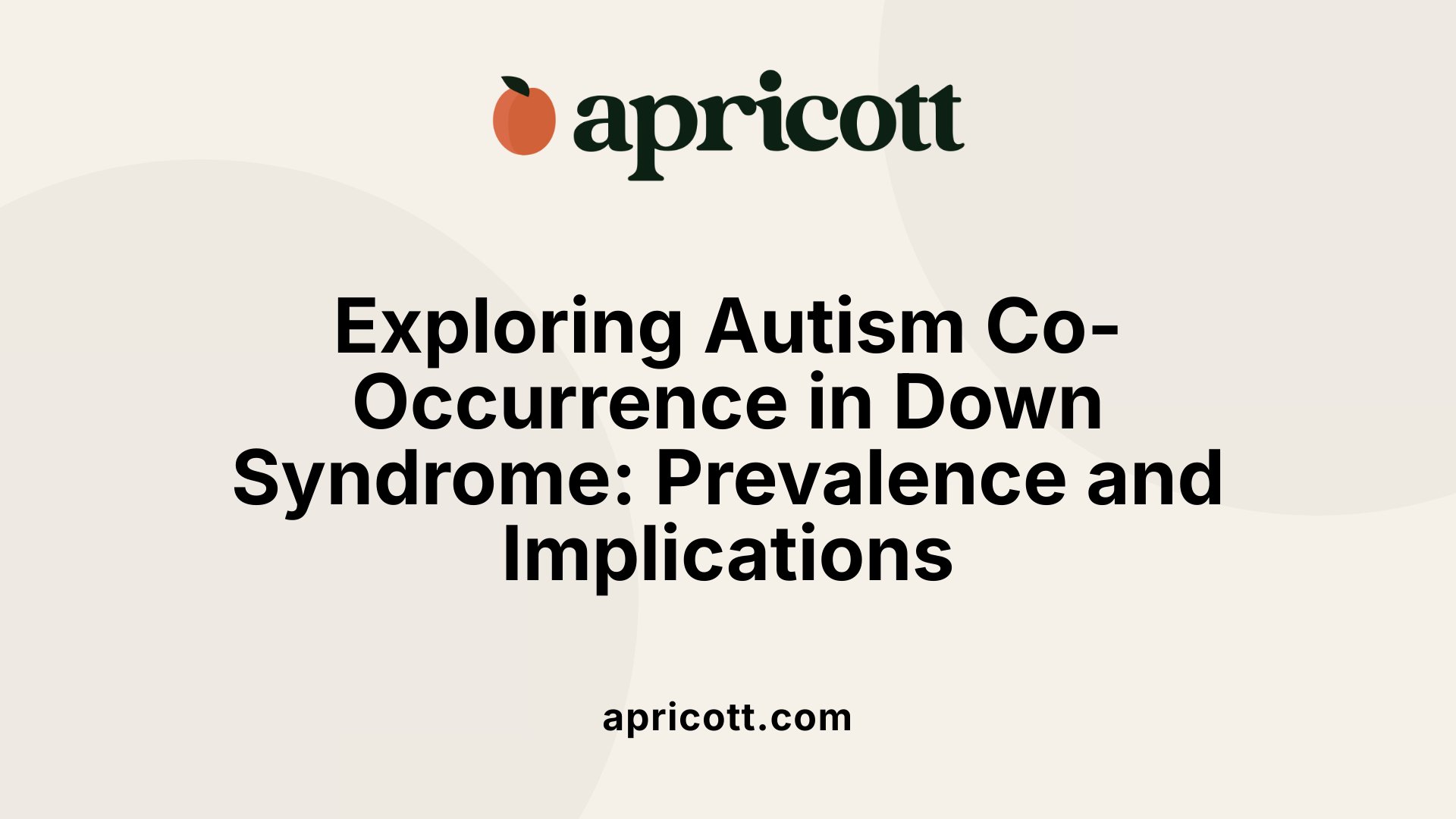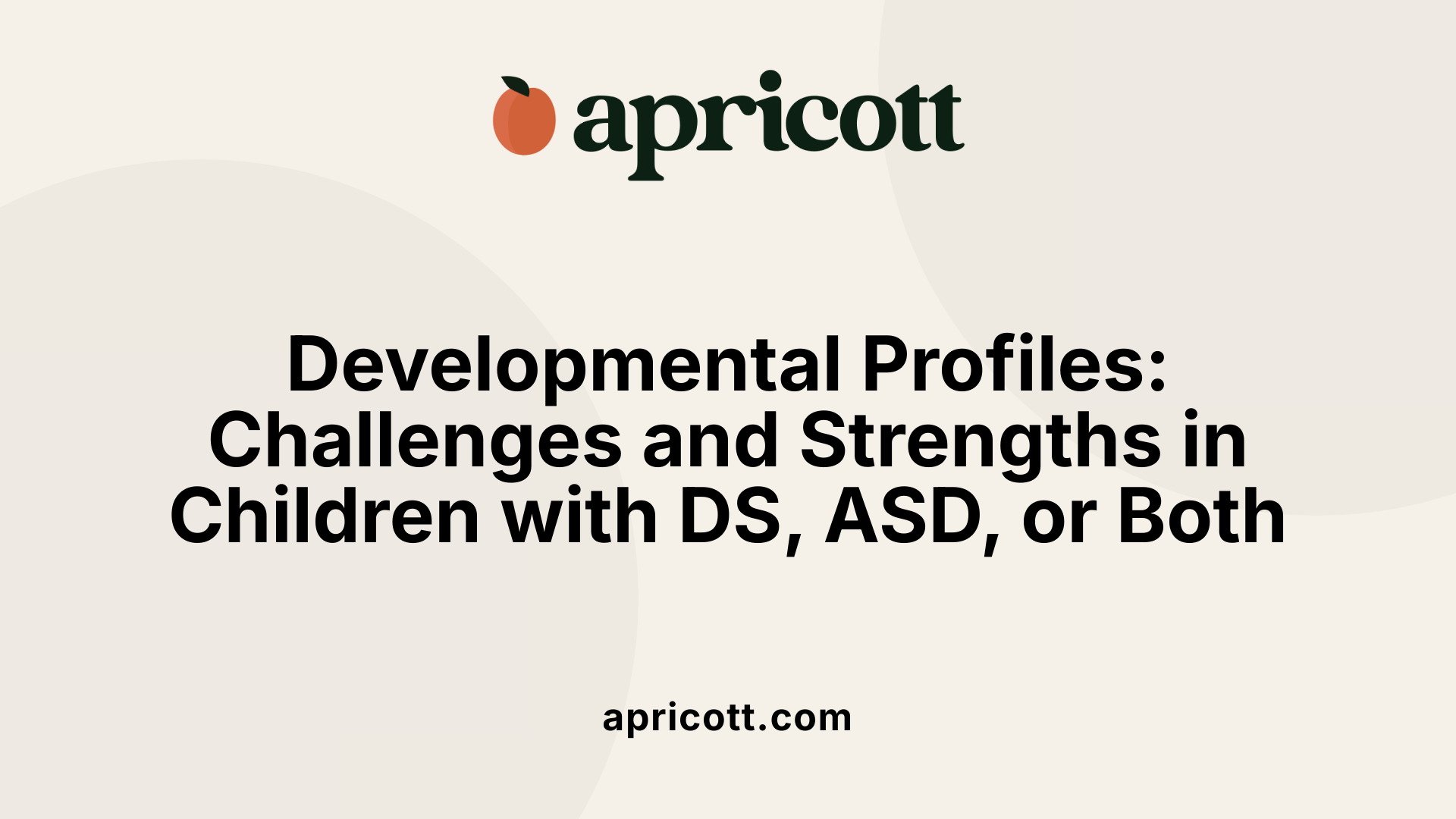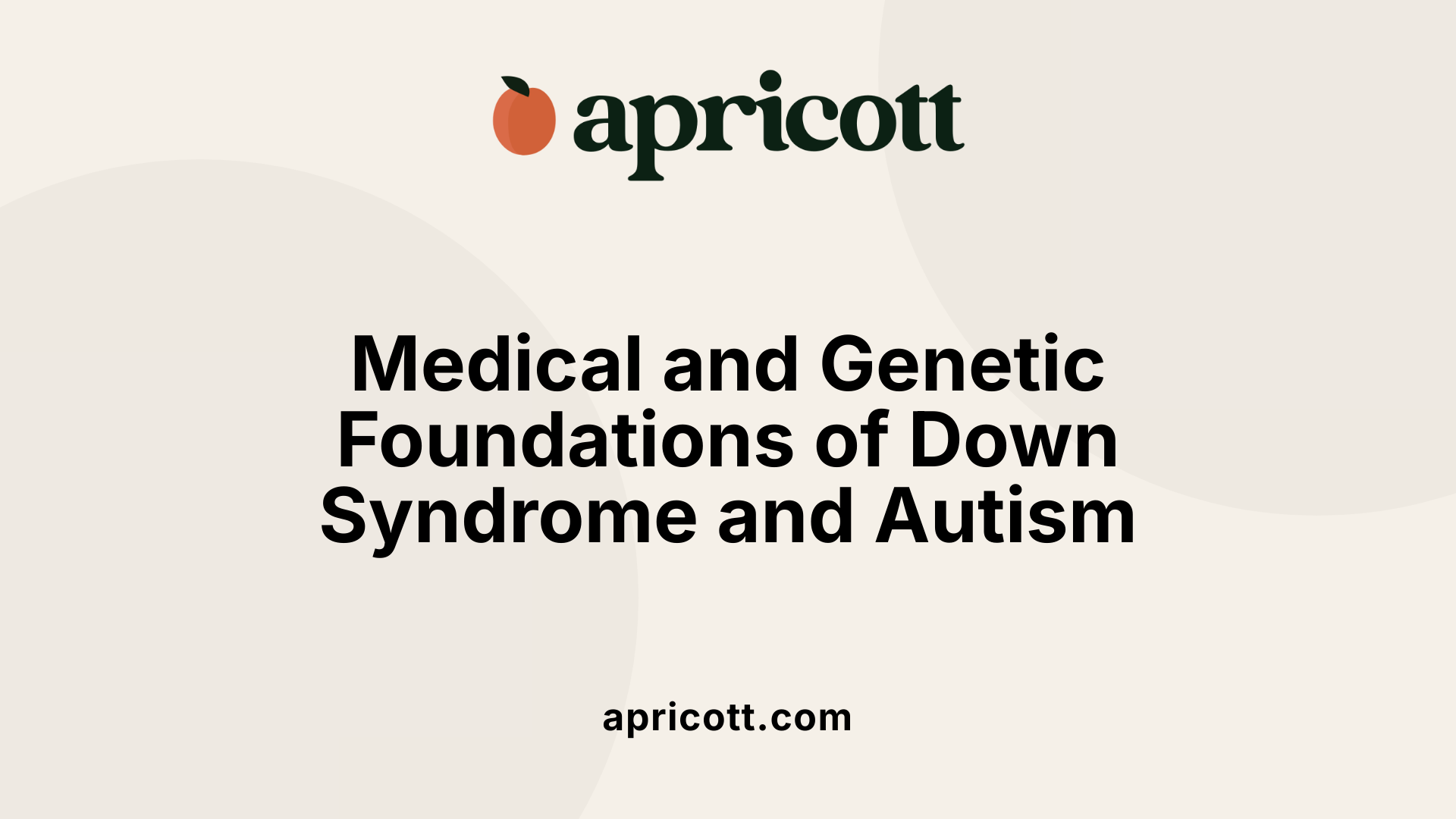August 18, 2025
Understanding the Intersection of Autism and Down Syndrome: Size, Symptoms, and Support
Autism spectrum disorder (ASD) and Down syndrome are distinct developmental conditions, each with unique characteristics and challenges. While they are separate diagnoses, research indicates a significant overlap, with 16-18% of individuals with Down syndrome also diagnosed with ASD. Understanding the differences, similarities, and the complexities of dual diagnosis is crucial for effective support, early intervention, and improving quality of life. This article explores the visual features, developmental profiles, diagnostic procedures, causes, and management strategies for both conditions, emphasizing how they intersect and diverge in the lives of affected individuals.

Facial features provide some of the most recognizable physical signs of Down syndrome. Individuals with this condition often display characteristic traits such as almond-shaped eyes that slant upwards, a flat facial profile, a small head, a single crease across the palm, and low muscle tone, which can influence their overall appearance. Their stature tends to be shorter with a tendency toward hypotonia, or decreased muscle strength.
In contrast, autism spectrum disorder (ASD) generally does not involve distinctive physical facial features. Instead, autism is primarily identified through behavioral and social communication differences. People with autism may appear physically typical or have diverse physical features, but these are not specific to the diagnosis.
When Down syndrome and autism co-occur, known as DS-ASD, individuals typically retain the physical features associated with Down syndrome. However, they may also present additional signs related to autism. These signs include limited eye contact, atypical facial expressions, and behaviors that reflect social and communication challenges.
Overall, physical facial differences are largely a hallmark of Down syndrome, making these features useful for early recognition. Autism’s symptoms, on the other hand, are mostly behavioral and social rather than physical. Recognizing the distinction is important for accurate diagnosis and appropriate intervention.

Down syndrome (DS) is a genetic condition caused by an extra chromosome 21. It is characterized by physical features such as a flattened face, upward-slanting eyes, and low muscle tone, along with intellectual disabilities. Unlike autism spectrum disorder (ASD), which is classified as a neurodevelopmental disorder involving social, communication, and behavioral challenges, Down syndrome itself is not on the autism spectrum.
However, many individuals with Down syndrome can also have ASD. Research shows that approximately 16-18% of people with DS are diagnosed with autism spectrum disorder, indicating a notable rate of co-occurrence. Some studies suggest the prevalence might be even higher, reaching up to 39% in certain populations.
The characteristics of autism—such as social and behavioral difficulties, communication challenges, and restricted interests—may appear alongside the typical symptoms of Down syndrome, including intellectual disabilities and speech delays. This dual diagnosis, often called DS-ASD, presents a complex profile that can include reduced social interest, repetitive behaviors like lining up objects or hand-flapping, and sensory sensitivities including overreacting to loud noises or textures.
Diagnosing ASD in children with DS can be challenging because many behaviors overlap. For example, social disinterest and communication delays are common to both conditions. Medical issues associated with Down syndrome, such as hearing or vision problems and sleep difficulties, can further complicate behavioral assessments.
Despite these complexities, early and accurate diagnosis by experienced professionals—such as neuropsychologists or developmental pediatricians—is crucial. It helps in tailoring therapies and interventions that address both conditions effectively. Early interventions, including behavioral therapies like Applied Behavior Analysis (ABA), speech, occupational, and physical therapies, can significantly improve developmental outcomes.
Understanding the co-occurrence emphasizes that children with DS and autism often have more significant challenges. They tend to show more severe communication, social, sensory, and behavioral difficulties compared to children with Down syndrome alone. Nonetheless, some children with DS-ASD display more social interest than those with ASD without Down syndrome, likely because of the inherent social motivation often seen in Down syndrome.
Statistics confirm the importance of awareness: about 1 in 640 children in the U.S. has Down syndrome, and within this group, the prevalence of ASD ranges widely but is estimated at around 16-18%. This rate is substantially higher than in the general population, where about 1 in 36 children are diagnosed with ASD. The higher prevalence underscores the need for careful screening and tailored support.
In summary, although Down syndrome is a distinct genetic condition and not on the autism spectrum, it frequently co-occurs with ASD. Recognizing this dual diagnosis allows for better understanding, targeted interventions, and supportive strategies to improve quality of life for affected individuals.
| Aspect | Description | Additional Details |
|---|---|---|
| Prevalence of ASD in DS | Approximately 16-18% | Higher in some studies up to 39% |
| Typical Features of DS | Physical features, intellectual delays | Physical health issues like heart defects |
| Autism Traits in DS | Social communication challenges, repetitive behaviors | Sensory sensitivities and behavioral issues |
| Diagnostic Challenges | Overlapping behaviors and medical conditions | Need for specialized assessment |
| Importance of Early Intervention | Improves development | Tailored therapies like ABA, speech, occupational |

Children with Down syndrome (DS) typically experience notable delays in expressive language and communication skills. Their developmental progress often plateaus during middle childhood, leading to persistent speech delays and difficulties with social interaction. These children usually have an uneven developmental profile, characterized by relative strengths in certain motor or social areas contrasted with weaknesses in language and cognitive domains.
In contrast, autism spectrum disorder (ASD) presents different developmental challenges. Children with ASD often exhibit impaired social communication, restricted interests, repetitive behaviors, and sensory sensitivities. Their social difficulties include challenges in understanding social cues, limited eye contact, and less enthusiasm for social engagement. Communication issues may include delayed speech, unusual language use, or reliance on gestures and alternative communication methods.
When both conditions co-occur, resulting in a dual diagnosis (DS+ASD), children tend to show a combination of these developmental profiles. They usually have more significant cognitive impairments compared to children with DS alone. Despite greater overall impairments, some studies suggest that ASD symptom severity might be less prominent in children with DS+ASD than in those with ASD without Down syndrome. However, their social-communication difficulties remain marked.
Developmentally, children with DS often experience periods of growth and stability, especially between ages 8 to 11. They may show uneven skill development, with some gains in motor or social skills and plateaus in language development. Meanwhile, children with ASD typically demonstrate early signs in social and communication challenges that become more evident over time.
Understanding these profiles is essential for early diagnosis and intervention. Targeted therapies tailored to their specific needs—such as speech and language therapy, occupational therapy, and behavioral interventions—can significantly improve outcomes. Recognizing the differences and overlaps helps caregivers and professionals develop strategies that support individual developmental trajectories.
Children with DS usually show mild to moderate intellectual disability, with language delays and motor coordination difficulties. They often develop social skills gradually but may struggle with complex communication and expressive language.
In children with ASD, delays are prominent in social engagement and receptive/expressive language. They may demonstrate repetitive behaviors such as lining up toys or hand-flapping, and sensory processing issues like hypersensitivity to sounds or textures.
For children with DS+ASD, delays are often more profound, affecting multiple areas of development. These children may exhibit more severe communication deficits, atypical social behaviors, and increased maladaptive behaviors such as tantrums or self-injury. Their sensory processing issues tend to be more intense, further complicating social and behavioral development.
Addressing these challenges requires comprehensive assessment and personalized intervention plans. Early and persistent support can help improve developmental outcomes and optimize the child's quality of life.

Detecting autism spectrum disorder (ASD) and Down syndrome involves different routes, reflecting their distinct causes and presentation patterns. Down syndrome, a genetic condition caused by an extra chromosome 21, can often be diagnosed shortly after birth through genetic testing, such as karyotyping or screening procedures. Early physical signs, like characteristic facial features and hypotonia, can also raise suspicion.
Autism, however, is primarily diagnosed through behavioral evaluations. It is a neurodevelopmental disorder characterized by social, communication, and behavioral challenges that become more apparent as children grow older, often around ages 2 to 3. Since autism has no definitive blood test, diagnosis depends on observing specific behaviors and developmental history.
In children with Down syndrome, identifying autism is complicated by overlapping behaviors and the unique developmental trajectories associated with DS. These children often already have speech delays and social differences, which can mask or mimic autism symptoms. Hence, clinicians need to carefully differentiate behaviors using tailored, developmentally appropriate assessment tools such as the Autism Diagnostic Observation Schedule (ADOS) and the Autism Diagnostic Interview-Revised (ADI-R). These instruments, however, are not specifically validated for children with DS, which can pose additional challenges.
Early screening in the first year or early childhood often involves parent-completed questionnaires like the Modified Checklist for Autism in Toddlers (M-CHAT) or the Social Communication Questionnaire (SCQ). Regular developmental surveillance is essential to track milestones, especially because children with DS are already at risk for speech and language delays.
In contrast, autism diagnosis in the general population relies on meeting criteria from the DSM-5, based on detailed behavioral observations and developmental history. Multidisciplinary approaches including psychologists, pediatricians, and speech-language pathologists are typical.
| Tool/Assessment | Purpose | Typical Use | Special Considerations |
|---|---|---|---|
| M-CHAT | Early autism screening in toddlers | First year or early childhood | Needs follow-up for positive screens in children with DS |
| SCQ | Autism screening | Early years | Validated in general populations, limited data for DS |
| ADOS | Behavioral assessment for autism | Confirmatory diagnosis | Requires trained clinician, adaptation needed for DS |
| ADI-R | Developmental and behavioral interview | Diagnostic confirmation | Time-consuming, requires caregiver interviews |
| Developmental Surveillance | Ongoing monitoring of milestones | Routine pediatric visits | Particularly important for children with DS |
Diagnosing ASD in children with Down syndrome is not straightforward. Many behavioral traits associated with DS, like speech delays, social differences, and repetitive routines, can overlap with autism features. This overlap can lead to over-diagnosis, where typical DS behaviors are mistaken for autistic traits, or underdiagnosis if signs are attributed solely to Down syndrome.
The variability in developmental levels among children with DS complicates interpretation. Some children with DS may show heightened sensory sensitivities or behavioral challenges that resemble ASD, but are not necessarily indicative of autism.
Moreover, assessment tools validated for neurotypical or general populations may not be fully appropriate for DS. Some behaviors common in children with DS, such as preference for routines or specific interests, might be misclassified as autistic behaviors.
Medical conditions prevalent in DS, like hearing or vision impairments, can further obscure behavioral assessments. For example, a child who is hard of hearing might display social withdrawal, which might be mistaken for social communication deficits.
Hence, a comprehensive, nuanced evaluation by professionals experienced with children with DS is crucial. These specialists consider the child's developmental history, medical background, and behavioral presentation, aiming to differentiate typical DS traits from those that warrant additional intervention for ASD.
Early detection of autism in children with Down syndrome can significantly improve outcomes. When identified early, tailored behavioral interventions such as Applied Behavior Analysis (ABA), speech therapy, and sensory supports can be implemented to address specific needs.
Supporting families with education and resources is also vital, enabling them to better understand the child's behaviors and participate actively in intervention strategies.
In conclusion, while the procedures for diagnosing autism differ from those for Down syndrome, especially in initial detection, the key lies in using developmentally sensitive, multidisciplinary assessments. Recognizing the overlapping signs and interpreting them with caution ensures timely, accurate diagnoses, and better support for children with dual diagnoses.

Down syndrome is caused by a chromosomal abnormality, specifically the presence of an extra copy of chromosome 21, known as trisomy 21. This genetic change results in distinctive physical features, intellectual disabilities, and various health conditions. The extra chromosome disrupts normal development, leading to the characteristic signs and symptoms associated with the disorder.
In contrast, autism spectrum disorder (ASD) arises from a combination of genetic and environmental factors affecting brain development. Unlike Down syndrome, autism does not stem from a single chromosomal change but involves complex interactions among multiple genes, along with environmental influences that may affect neural pathways.
Both conditions influence brain development but through different biological mechanisms. Down syndrome impacts multiple body systems due to the extra genetic material, whereas autism involves alterations in brain structure and function, impacting social, communication, and behavioral skills.
Down syndrome is strictly linked to a chromosomal abnormality—trisomy 21—where every cell contains an additional chromosome 21. This can happen due to nondisjunction during cell division, resulting in the extra chromosome.
Autism spectrum disorder is less straightforward genetically. It is considered a neurodevelopmental disorder caused by multiple genetic mutations and variations. Some genes associated with autism involve synaptic functioning, brain growth regulation, and neural connectivity. These genetic factors can be inherited or occur spontaneously.
Environmental factors, such as prenatal exposures, may also influence the risk of autism development, but these are not linked to chromosomal abnormalities like those seen in Down syndrome.
Though Down syndrome and autism have distinct biological origins—chromosomal abnormality versus multifactorial genetic and environmental influences—they can co-occur in the same individual, a condition known as dual diagnosis. This overlap occurs in approximately 16-18% of individuals with Down syndrome, indicating a significant relationship but not a direct shared cause.
While no specific genetic marker or chromosome is known to directly cause autism, research suggests that some neurodevelopmental pathways shared across different conditions could be involved. For instance, differences in brain regions such as the cerebellum and corpus callosum have been observed in individuals with both Down syndrome and autism, hinting at some neurobiological overlaps.
In summary, the causes of Down syndrome and autism differ fundamentally—chromosomal abnormality versus complex genetic interactions—yet they can intersect, with some individuals experiencing both conditions. This intersection underscores the importance of genetic research and detailed neurodevelopmental studies to better understand overlapping mechanisms and potential shared pathways.
| Condition | Cause | Category | Additional Details |
|---|---|---|---|
| Down syndrome | Extra copy of chromosome 21 (trisomy 21) | Chromosomal abnormality | Nondisjunction during cell division |
| Autism spectrum disorder | Multifactorial genetic and environmental influences | Complex neurodevelopmental | Multiple genes involved; environmental factors may contribute |
| Overlap and Comorbidity | Co-occurrence in some individuals | Dual diagnosis | Up to 18% with Down syndrome also have autism |
Understanding the genetic and chromosomal differences and overlaps helps in better diagnosis, management, and research into targeted therapies for individuals affected by one or both conditions.
Support and intervention strategies are essential for helping individuals with autism spectrum disorder (ASD), Down syndrome (DS), or living with both conditions, improve their quality of life and achieve their full potential.
For autism, there is no cure, but numerous therapies focus on developing communication, social skills, and reducing challenging behaviors. Early intervention is particularly crucial and typically includes applied behavior analysis (ABA), which is a structured therapy aimed at increasing positive behaviors and teaching new skills. Speech therapy can help improve language and communication abilities, while occupational therapy assists with sensory integration and daily living skills. Physical therapy may also be used to strengthen motor skills.
Medications are used selectively to manage symptoms such as anxiety, hyperactivity, or irritability; however, they do not treat the core aspects of autism.
Individuals with Down syndrome benefit from tailored care that addresses their specific health needs. Early intervention programs, including speech, occupational, and physical therapies, are vital to support their developmental progress. Medical management of health-related issues like heart defects, sleep difficulties, and thyroid problems is also important.
A multidisciplinary team approach is recommended, involving healthcare providers, therapists, educators, and families. Personalized care plans ensure interventions are suited to each individual's unique strengths and challenges.
Supporting families is critical in managing the complex needs of children with autism and Down syndrome. Education about the conditions helps caregivers understand behaviors and developmental stages.
Respite care services provide temporary relief for families, allowing them to rest and recharge.
Joining support groups and advocacy organizations offers emotional support, practical advice, and a sense of community. These groups also advocate for policy changes and increased resources.
Families are encouraged to participate actively in intervention planning, attend therapy sessions, and implement strategies at home, such as visual aids and structured routines, to reinforce skills.
Numerous organizations and community programs provide resources for families and individuals. The Down Syndrome Program at Mass General and other local clinics offer specialized services and support networks.
Educational programs, social skills groups, and camps tailored for children with developmental differences promote inclusion and social participation.
Government agencies often provide funding and access to therapeutic services and early intervention programs.
Online platforms and mobile apps now also facilitate access to behavioral strategies, social stories, and educational content.
| Resource Type | Description | Target Audience |
|---|---|---|
| Healthcare Providers | Multidisciplinary teams, specialists, clinics | Families, individuals with ASD and DS |
| Support Groups | Community-led organizations, parent networks | Families, caregivers |
| Educational Resources | Workshops, online courses, therapeutic tools | Educators, therapists, families |
| Community Programs | Social skill groups, recreational activities | Children and teens with developmental disorders |
The connection between autism spectrum disorder (ASD) and Down syndrome (DS) has become a focus of recent research, revealing that children with DS are significantly more likely to also have autism compared to the general population. Estimates indicate that between 5% and 39% of individuals with Down syndrome are diagnosed with autism, a prevalence much higher than in children without DS.
This dual diagnosis, often referred to as comorbidity, presents with overlapping and sometimes more severe behavioral and developmental challenges. Children with both conditions tend to show greater difficulties in social communication, such as delayed responses, reduced eye contact, and diminished social interest. They also exhibit prominent repetitive behaviors like lining up objects, hand-flapping, and rocking, alongside sensory sensitivities to noises, textures, and sights.
Diagnosing autism within the DS population can be complex because many behaviors associated with autism overlap with typical features of Down syndrome, such as communication delays and physical characteristics. Nevertheless, early recognition—often around age 3 to 4—is critical, although formal diagnosis might not occur until age 8 or later due to developmental variability.
Behaviorally, children with DS and ASD often display increased irritability, stronger behavioral challenges, and more pronounced sensory processing issues. Neuroimaging studies have contributed valuable insights, showing differences in brain structures like the cerebellum and corpus callosum, which are associated with the combined presentation. These findings suggest alterations in brain connectivity and development may underlie the coexistence of these conditions.
Medical factors also play a role. Children with DS and ASD frequently experience additional health issues like gastrointestinal problems, seizures, and sleep disturbances, which can complicate diagnosis and management.
Understanding these relationships underscores the importance of comprehensive assessments, including behavioral, developmental, and medical evaluations. Early diagnosis allows for targeted interventions—behavioral therapies, speech and occupational therapy, and medical management—that can significantly improve quality of life and functional outcomes for individuals with dual diagnoses.
Existence of co-occurrence of ASD in children with DS is well-supported, with a significant portion experiencing severe cognitive, behavioral, and sensory challenges. Neurobiological research points to structural brain differences and abnormal neural pathways, which help explain some of the shared and unique features of both conditions.
Recent advances in neuroimaging, including MRI and functional imaging techniques, have identified notable disparities in brain regions like the cerebellum and corpus callosum in children with DS and ASD. These differences may correlate with deficits in coordination, social cognition, and communication. Genetics research indicates that the genetic mechanisms underlying DS (trisomy 21) and ASD are distinct, but interactions between the extra chromosome and other genetic or environmental factors can influence neurodevelopmental outcomes. Ongoing studies aim to clarify these complex relationships further.
As understanding deepens, future strategies are likely to focus on personalized medicine approaches. Early detection and intervention will remain cornerstones, utilizing behavioral therapies such as Applied Behavior Analysis (ABA), speech therapy, and sensory integration therapy. Emerging research suggests that neurodevelopmental pathways can be modulated with targeted pharmacological treatments, improving behavioral, cognitive, and sensory functions. Advances in neuroimaging may also help track treatment responses and guide therapy adjustments. Furthermore, genetic research may pave the way for preventative or early therapeutic strategies tailored to individuals' specific genetic profiles, potentially reducing the severity of ASD symptoms in children with DS. Overall, a multidisciplinary approach combining genetics, neuroimaging, behavioral science, and medical management holds promise for improving outcomes in this complex population. Continued research will help clarify mechanisms and optimize intervention protocols, ultimately supporting individuals with DS and ASD to lead more fulfilling lives.
While autism and Down syndrome are distinct conditions, their intersection highlights the importance of comprehensive assessment, early diagnosis, and tailored intervention strategies. Recognizing the signs of autism in individuals with Down syndrome can facilitate targeted therapies that improve communication, social skills, and behavioral regulation, ultimately enhancing their quality of life. Advances in neuroimaging, genetics, and personalized medicine continue to deepen our understanding of these complex neurodevelopmental conditions. Support resources, community programs, and a multidisciplinary approach are vital for empowering affected individuals and their families. As research progresses, the goal remains to optimize development, foster independence, and ensure that every individual receives the care and support they need to thrive.